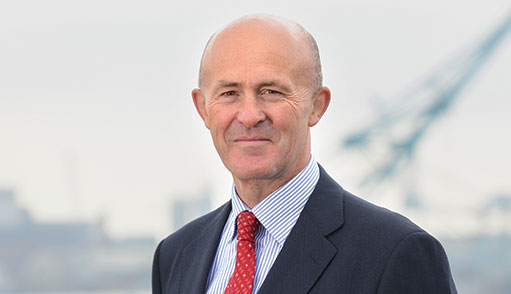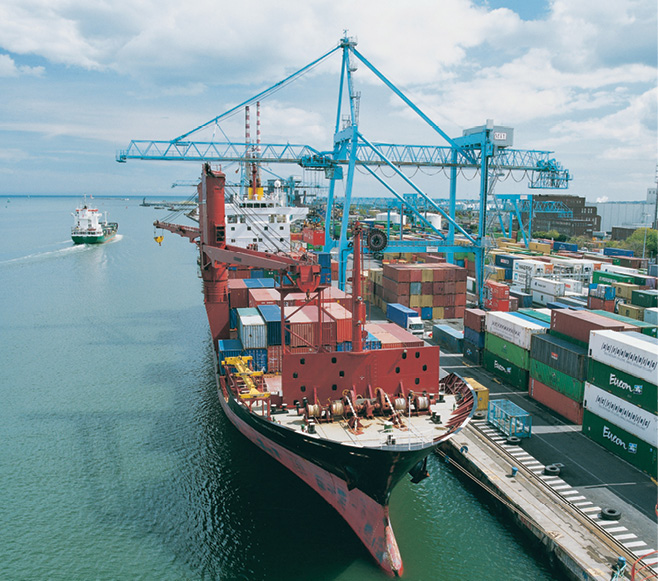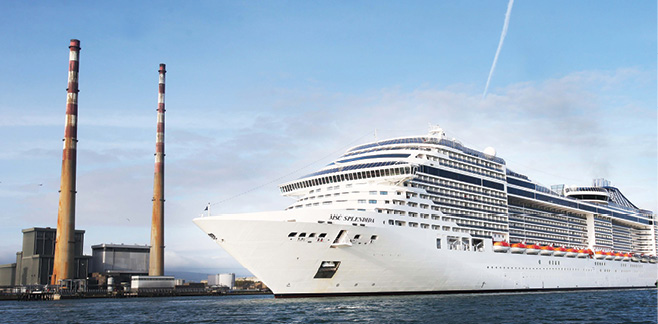Dublin Port: crest of a wave


Dublin Port Company Chief Executive Eamonn O’Reilly talks to eolas about its Masterplan to futureproof the port for the next 30 years to ensure it can grow with demand.
Dublin Port is literally riding on the crest of a wave. The tide has turned following the economic downturn, when both imports and exports declined, and over the last four years Dublin Port has recorded growth of 25 per cent, with cargo volumes up to 34.9 million gross tonnes in 2016 alone.
Despite this success in recent years Chief Executive Eamonn O’Reilly and his management team are firmly fixed on the future.
Dublin Port Company has commenced work on the Alexandra Basin Redevelopment (ABR) Project, the largest single project in the Port’s 300-year history. The development will increase Dublin Port’s berth capacities using the Port’s existing footprint and deepening the channel and approach to the Port.
This will result in a higher volume of larger freight and passenger ships being accommodated at multi-purpose berths.
The ambitious build is part of Dublin Port’s Masterplan 2012–2040, which is a framework to guide the development and operation of the port over 30 years.
It provides a vision as to how Dublin Port could be developed to cater for an anticipated doubling in port volumes up to 2040. However sustained levels of growth in recent years show that the level of demand for port infrastructure will likely to be greater than originally anticipated and the Masterplan is under review.
The review, the first since 2012, is taking account of changes in port operations, logistics, trade developments and relevant policies impacting on Dublin Port. It continuously looks to the future to refine the infrastructure development options for the Port.
O’Reilly says the Masterplan is not just about expanding Dublin Port as a commercial entity, but recognising the potential for its use as an amenity to the capital, its population and visitors.
Transport and connectivity play a major role in that.

“Connectivity is a significant part of our future plans,” says O’Reilly. “Connecting the North and South Ports, the South Port with the Port Tunnel, the Port with a significant landbank near the motorway network for non-core Port activity, and the city and its people with the port. Port-city integration is a major strategic objective for us.
“The Masterplan shows how Dublin Port can be developed in future years to cater for foreseeable growth. It also provides customers and users of the Port with some certainty about the future.”
Dublin Port Company believe that the Port can be developed within the Port’s existing footprint and without significant major infill works. This will require the maximum utilisation of brownfield sites and adjacent river berthage.
Proposals to improve connectivity between the Dublin Port Tunnel and the South Port would unlock significant additional port capacity on the Poolbeg Peninsula for increasing traffic from both Ro-Ro and Lo-Lo vessels.
Plans include developing the Port’s road network to cater for projected volumes, and building a new 4km long pedestrian and cycle greenway on the northern perimeter of the Port overlooking the Tolka Estuary. Planning permission has been secured for a pedestrian and cycleway cable-stayed bridge across Promenade Road and dedicated cycleways throughout the Port.
O’Reilly says the range of initiatives envisaged also includes the development of an environmentally friendly bus operation to service the Port estate, including ferry terminals, and developing a partnership with Dublin City Council and the Irish Nautical Trust to re-establish a Liffey service.
“All of these proposed infrastructural measures will make the Port more accessible to both businesses and the general public. One of our big challenges was to create stronger links between the Port and the city and through changes like these and projects in the community we believe we can achieve that,” O’Reilly adds. “It is important the public see and understand our plans for the future.”
A series of public consultations with all stakeholders, including residents living in the vicinity, have been held in recent months to show how best the Port can use its own lands to increase the throughput capacity of the Port.
Among the areas examined were:
• The creation of a Unified Ferry Terminal for the Port’s main ferry operators incorporating all facilities required for the State including immigration, customs, security and other border inspection functions.
• The redevelopment of up to 22 hectares of lands at the Port following the removal of non-core activities.
• The development of up to 43 hectares of Port lands on the Poolbeg Peninsula.
• The addition of the 44 hectare Dublin Inland Port adjacent to Dublin Airport to provide facilities for non-core but port-related activities.
O’Reilly says it is prudent to respond to changing circumstances. “We have experienced tremendous growth in recent years, and we anticipate an annual growth rate of 3.3 per cent. We must respond to circumstances which will impact on the Port’s capacity to grow.
“Last year, in 2016, the volume of imports increased by 6.1 per cent, while exports rose by 6.7 per cent. We also recorded growth across all unitised freight modes, while new trade vehicles through Dublin Port increased by 2 per cent to 104,185. We also saw 1.8 million ferry passengers and almost one million freight vehicles passed through the Ports Ferry Terminals. We have to meet that growing demand,” he says.
The development of a Unified Ferry Terminal will rationalise the existing three separate terminals and maximise Port lands.
Growth
While volumes at Dublin Port are some 13 per cent higher than they were at the peak of the boom in 2007, they are expected to more than double to 77 million gross tonnes by 2040.
Dublin Port’s Masterplan reflects these figures, as well as developments in policies governing planning, national transport, the environment and the economy. The recent review also took account of international developments, including Brexit.
O’Reilly believes that as Dublin Port survived the impact of the recession, and recovered over such a short period, any effects of Brexit are likely to be without any major or long-term impact on the business.
“Despite concerns over Brexit, particularly relating to imports and exports to Britain, we still envisage significant growth across the sector. Our strategic plans will futureproof Dublin Port until 2040 and beyond,” O’Reilly says.
“We have purchased 44 hectares of motorway connected lands near Dublin Airport, 14km from the Port, for non-core Port activity like the storage of new cars and containers. This in turn will free up lands at the Port where we plan to develop over 50 hectares for core activity.”
Dublin Port has a track record of financing major infrastructure projects, such as the Alexandra Basin Redevelopment Project, which commenced in early November last year, thus providing certainty and allowing cargo handlers, ferry companies and cruise lines to plan and invest accordingly.
The first major project from the Masterplan – the ABR Project is transforming the Port’s infrastructure by deepening and lengthening 3km of the port’s 7km of berths. It will also deepen the port to provide an entrance channel with a depth of at least 10 metres.
Once complete, Dublin Port will have the infrastructure and capacity to cater for larger sized vessels and increased trade volumes.
As well as benefitting trade, this will safeguard the future of cruise tourism to the capital. The project will enable the world’s largest cruise liners to routinely call at Dublin Port, turn within Alexandra Basin and berth as far upriver as East Link Bridge within strolling distance of public transport connections.

Cruise
Cruise may represent a small proportion of Dublin Port’s business, but it shows significant potential for growth.
Dublin Port’s 2017 cruise season will see 130 cruise calls berth in the capital, bringing over 200,000 passengers and crew to visit the city and benefit the local economy. However, of the record number of cruise calls scheduled this year, seven ships measure longer than 300 metres and are brought stern first (reversed) up the River Liffey as they cannot turn in the port.
O’Reilly says the ABR Project is expected to result in an extra 600,000 tourists for the city annually, three times current visitor levels.
One ship, Celebrity Eclipse, will become the first major cruise line to call Dublin Port a ‘home port’ when she returns next year for a mini-season of holidays to Northern Europe. Over 14,000 people are expected to begin their holiday from Dublin Port in 2018.
“Dublin Port has the potential to become a home port for a significant proportion of the cruise industry. Its proximity to the vibrant, historic city centre and Dublin Airport places it in an ideal location. While home porting will require increased hotel capacity and improved transport links around the capital, the knock-on economic benefit to the capital and region will be significant,” he adds.
“The tourism sector is increasing year-on-year and we can tap into that more and more as Dublin Port develops its infrastructure. We have worked hard to attract new markets and cruise lines and established Cruise Dublin to market Dublin internationally as Ireland’s premier port of choice for cruise.”
Throughout the redevelopment, Dublin Port is taking steps to re-establish links with the city through a range of cultural, arts and industrial heritage initiatives on the theme of Port-City integration.
The reimagining of a 150-year old Diving Bell on Sir John Rogerson’s Quay – now Dublin’s smallest museum – and commissioning a series of original and innovative public artworks and installations are among the initiatives, along with plans to soften the Port’s boundaries through high quality architectural and landscaping design.
Again these works – the first at Port Centre in 35 years – are part of the Port’s overall Masterplan.
“When complete, this scheme will fully integrate with our future plans for a new internal road network, cycle and pathways that will give pedestrians and cyclists the opportunity to access the port estate for recreational use for the first time,” concludes O’Reilly.
Dublin Port Company
Port Centre
Alexandra Road, Dublin 1
T: +353 1 887 6000
F: +353 1 855 7400
W: www.dublinport.ie
Facebook: www.facebook.com/DublinPortCompany
Twitter: twitter.com/DublinPortCo






